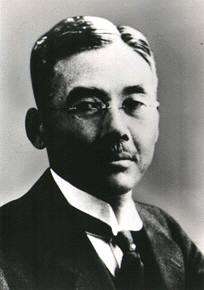Junnosuke Inoue

Junnosuke Inoue (井上 準之助 Inoue Junnosuke, May 6, 1869 – February 9, 1932) was a Japanese businessman and central banker. He was the 9th and 11th Governor of the Bank of Japan (BOJ).
Biography
Inoue was born in Ōita Prefecture.[1] In 1897, Inoue was a BOJ trainee along with Hisaakira Hijikata. Both young men were sent by the bank to learn about British banking practices in London.[2] From 1913-1919, Inoue was head of the Yokohama Specie Bank[3] Inoue was Governor of the Bank of Japan from March 13, 1919 – September 2, 1923 and again from May 10, 1927 – June 1, 1928.[4] and Minister of Finance in 1923-1924 and 1929-1931. He briefly presided the Institute of Pacific Relations between Ray Lyman Wilbur nomination as United States Secretary of the Interior and his own second nomination as Japan Minister of Finances.
In 1932, Inoue was one of two prominent Japanese assassinated in the League of Blood Incident.
Notes
- ↑ Bank of Japan (BOJ), 9th and 11th Governor
- ↑ Metzler, Mark. (2006). Lever of Empire: the International Gold Standard and the Crisis of Liberalism in Prewar Japan, p. 9., p. 9, at Google Books
- ↑ Tamaki, Norio. (1995). Japanese banking: a History, 1859-1959, p. 120, p. 120, at Google Books
- ↑ BOJ, List of Governors.
References
- Metzler, Mark. (2006). Lever of Empire: the International Gold Standard and the Crisis of Liberalism in Prewar Japan. Berkeley: University of California Press. ISBN 9780520244207; OCLC 469841628
- Tamaki, Norio. (1995). Japanese banking: a History, 1859-1959. Cambridge: Cambridge University Press. ISBN 9780521496766; OCLC 231677071
| Political offices | ||
|---|---|---|
| Preceded by Otohiko Ichiki |
Minister of Finance 1923–1924 |
Succeeded by Kazue Shōda |
| Preceded by Chuzo Mitsuchi |
Minister of Finance 1929–1931 |
Succeeded by Korekiyo Takahashi |
| Government offices | ||
| Preceded by Yatarō Mishima |
Governor of the Bank of Japan (1st term) 1919–1923 |
Succeeded by Otohiko Ichiki |
| Preceded by Otohiko Ichiki |
(2nd term) 1927–1928 |
Succeeded by Hisaakira Hijikata |